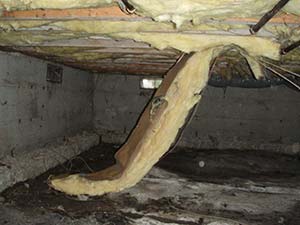Wet Insulation
When most homes are built, the crawl space is insulated with a traditional fiberglass material. Unfortunately, this isn’t a material that is “cut-out” for this type of environment, especially if the crawl space itself hasn’t been properly sealed off from the outside world.
When fiberglass insulation gets wet, it deteriorates, falls apart, and this can leave wooden structures, including support beams and floor joists exposed and susceptible to serious moisture damage.
Warning Signs of Wet Insulation
The following problems can usually be seen or noticed whenever there is damp insulation inside of the crawl space:
- Home smells musty – this could be due to mold growth inside of the fiberglass materials.
- Energy bills seem to be increasing each month.
- Home doesn’t feel as comfortable as it once did – either is too hot or cold.
- Some spots on the first level of the home feel un-level or as if they are sagging – this could be from the exposed wood rotting and deteriorating under the floor.
- During a visual inspection of the crawl space, chunks of fiberglass can be seen lying on the ground.
Crawl Space Mold
Additionally, as time passes, the wet insulating material can foster the development of dangerous mold. This mold releases spores up and into the air, eventually making its way into the living areas of the home. Once breathed in, this mold can cause a variety of health problems, including: respiratory problems, headaches, fatigue, skin rashes, eye irritation, asthma attacks, allergies, or cold/flu-like symptoms. It can also cause a home to smell very musty with contaminated and unhealthy air.
Replacing the Insulation
It is important to have the right kind of insulating material in place below a home. A crawl space must be properly insulated so that conditioned air from inside the home isn’t able to get out, and hot/cold air from outside isn’t able to get in. This can help to save a homeowner quite a bit on their monthly energy expenses since their HVAC equipment will be much more energy efficient.
Typically speaking, spray foam insulating materials will need to be used inside of the crawl space environment. Unlike traditional fiberglass which is made from batts, spray foam is a polyurethane mix of materials which won’t be able to foster the development of dangerous mold under a home. It will also protect important wooden structures below the home.

